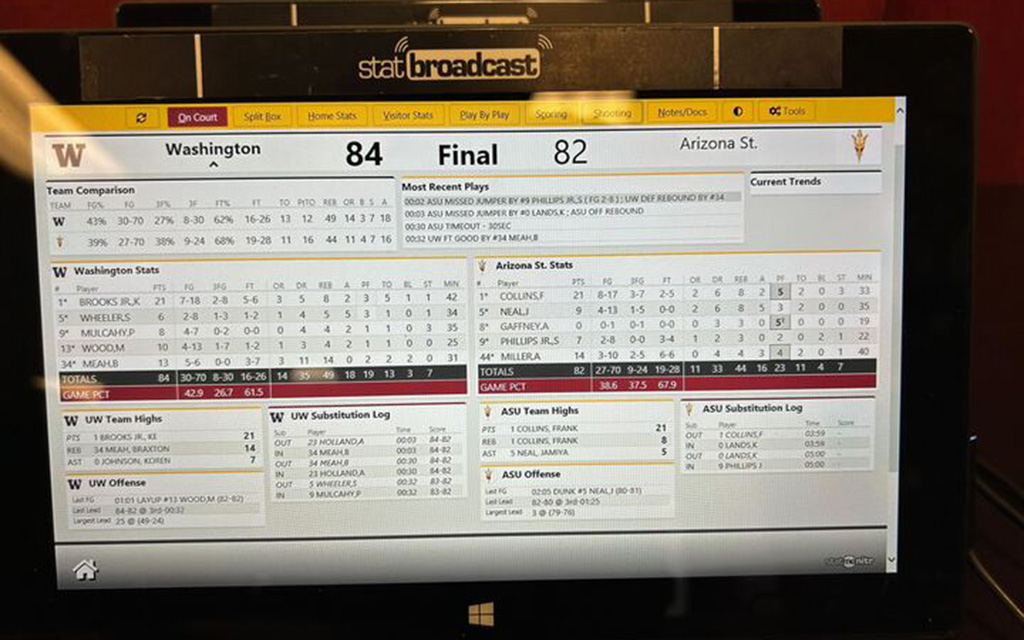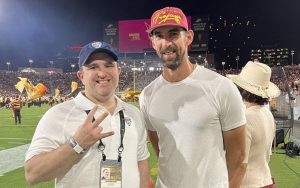
Started by Arizona State media relations intern Nate Policar, the StatBroadcast system is used by universities around the country. (Photo by Tia Reid/Cronkite News)
TEMPE – Nate Policar was just a college student at Arizona State when he created a program that would revolutionize college sports. Over a decade before the start of a nine-year streak that recognized ASU as the most innovative school in the nation, Policar was ahead of the curve, spearheading a new wave of live events data.
College sports are known for their ever-changing landscape, a world that is immensely different from what it was at the NCAA’s inception in 1906. One change that has helped revolutionize college athletics is live stats.
Around the country, at most Division I schools and major collegiate athletic conferences, StatBroadcast, a sports statistics technology program, distributes live statistics for the vast majority of athletic events. It has developed programming for football, men’s and women’s basketball, baseball, softball, gymnastics, volleyball, soccer, lacrosse and other sports.
Not only is this nationally used program a staple at athletic events at ASU, but it also has a deeper connection to the Valley. Policar, StatBroadcast’s founder, worked as a student intern in Sun Devil Athletics sports information department beginning his freshman year at ASU in 2002.
“My first job as a freshman was to run up and down (to) the elevator from the press box to the office to get updated scores every 10 minutes and bring them back up to Xerox them because there was no such thing as internet up in the press box at that point,” Policar said. “… We used to run these old big monitors with telephone wire across the court at the basketball arena, and so I said, ‘There has to be a better way to do this.’”
Policar, who spent time studying computer science and computer information systems before graduating with a bachelor’s degree in Information Systems, a minor in Mass Communications and a Masters of Business Administration from ASU, already had the foundational base to code a program that could alleviate the burden on the department and himself as an intern. During the 2006 football season, he found a source of motivation to push him toward actually cultivating the idea.

Nate Policar, left, on the ASU sidelines with Olympic swimmer Michael Phelps, graduated with a bachelor’s degree in Information Systems, a minor in Mass Communications and a Masters of Business Administration from ASU. (Photo courtesy of Nate Policar)
“The original plan was to figure out how to get into the (BCS National Championship Game),” Policar said. “And then it kind of snowballed into, ‘OK, I’m doing this every week for ASU athletics and fighting with these old systems, so how can we come up with a modern system that works without having to have intervention?’”
Following the championship game, StatBroadcast slowly became more prevalent. As internet capabilities in ASU’s athletic facilities advanced, Policar’s technology was used for more events. When visiting schools came to Tempe to play ASU and saw StatBroadcast in action, employees of those universities began exploring ways to implement the program’s use for their events.
Now, it’s almost impossible to imagine a college sporting event without some form of live stats, be it StatBroadcast or any of the other sport-specific programs that have appeared in its wake.
“There’s been a couple games where the stats are down,” said Doug Tammaro, ASU’s senior associate athletic director of media relations. “So you don’t have StatBroadcast, maybe the stats are down, or the wireless is down. And I tell people it’s like if every sport was a boxing match, where you don’t know the score till the end, what if you didn’t know the score? And that’s kind of what it would be like, and so, there’s just no way now you don’t know the score.”
Tammaro worked in college sports for years before StatBroadcast was even a concept. He saw firsthand the development and implementation of Policar’s invention at ASU and nationwide.
As ASU prepares to make the jump from the Pac-12 Conference to the Big 12 Conference, Tammaro finds that Policar’s product is more relevant than ever. Whenever he gets the chance, Tammaro doesn’t hesitate to brag about his former intern.
“I’m proud,” Tammaro said. “I was on a Big 12 Conference call about a week ago with their associate commissioner for communications, and he brought up StatBroadcast. And when he brought it up, he was talking about what it does, and ‘Do you guys have it?’ and we were talking, and it was cool to say, ‘Hey, just so you know, that guy’s an alum of ASU, and he worked in our office as a student assistant.’
“And the guy’s like, ‘Wow.’ I randomly will tweet as I’m sitting, looking at a StatBroadcast monitor. This is an ASU guy. This is a guy we’re proud of.”
While StatBroadcast is tremendously beneficial for the athletic departments at individual schools, it is also an invaluable tool for media members who cover college athletics. Local and national beat writers, student broadcasters and professionals all benefit from having live stats at their fingertips with just the click of a button.
The Pac-12 Network’s Daron Sutton has broadcasted college events on the West Coast for over a decade. The jack-of-all-trades has called events for volleyball, soccer, basketball, baseball, softball, gymnastics and wrestling for the Pac-12. StatBroadcast is one of the resources that regularly adds to his broadcast quality.
“Over the last even couple of years, I have gone to places (where) the university hasn’t been partners with StatBroadcast,” Sutton said. “And it’s night and day. … I think I view it more as a positive when I have it and not as much as a negative when I don’t. … We all have a tool basket or a toolbox when we sit down to do a game and what’s in it. … One of the great tools Is StatBroadcast.”
In the nearly 20 years since it was created, StatBroadcast has evolved in a variety of ways. Its live statistics information is no longer only used by media and athletic departments. Fans of more obscure sports rely on the information when they are unable to access streams and broadcasts of the sports they follow.
Policar, who is now StatBroadcast Systems president, has spent years developing the product to be able to display information from as many sports as possible. He even has aspirations of creating a version of the product that can be used to provide real-time data for high school sports.
Even with the product’s advancements, it isn’t perfect. There can be outages or displays that don’t work for every sport. However, Policar takes pride in his company’s desire to fix issues as quickly as possible and implement feedback when it’s given.
“I think it’s kind of a hallmark of our success is that I have always encouraged feedback,” Policar said, “and when we’ve gotten feedback, not just implemented, but tried to implement it quickly. … For me, if somebody sends us an idea and it makes the product better, (I) have the juice to want to go right back to the office and get it implemented as soon as possible because, for me, I want to see this be the best possible version of itself that it can be.”
As StatBroadcast continues to evolve and become more prevalent in more sporting events at more schools across the country, the product’s reach astounds Policar, who never imagined its impact would be this great.
“The first year when the NCAA called me and said they were gonna fly me out to sit courtside at the Final Four, that was the moment for me where I was like, ‘Is this really happening?’ Policar said. “At that point, I was still like, ‘Is this (real)? Am I for real?’
“And now, with 37 conferences using us, we’re the exclusive provider for NCAA championships. A lot of scoreboard data you see on NCAA.com, Fox.com, ESPN all flows through our systems, so it’s kind of become real at that point.”

